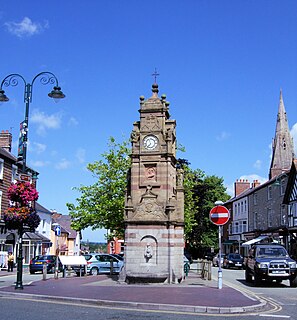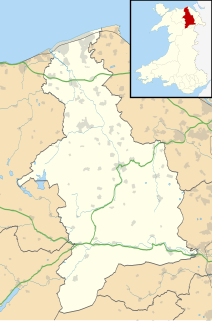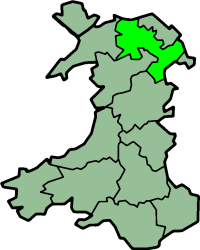
Ruthin is a market town and community in Denbighshire, Wales, in the south of the Vale of Clwyd. It is Denbighshire's county town. The town, castle and St Peter's Square lie on a hill, skirted by villages such as Pwllglas and Rhewl. The name comes from the Welsh rhudd (red) and din (fort), after the colour of sandstone bedrock, from which the castle was built in 1277–1284. The Old Mill, Ruthin, is nearby. Maen Huail, a registered ancient monument attributed to the brother of Gildas and King Arthur, stands in St Peter's Square.

Denbighshire is a county in the north-east of Wales. Its borders differ from the historic county of the same name. This part of Wales contains the country's oldest known evidence of habitation – Pontnewydd (Bontnewydd-Llanelwy) Palaeolithic site has Neanderthal remains of some 225,000 years ago. Castles include Denbigh, Rhuddlan, Ruthin, Castell Dinas Bran and Bodelwyddan. St Asaph, one of Britain's smallest cities, has one of its smallest Anglican cathedrals.

Historic Denbighshire is one of thirteen traditional counties in Wales, a vice-county and a former administrative county, which covers an area in north east Wales. It is a maritime county, bounded to the north by the Irish Sea, to the east by Flintshire, Cheshire and Shropshire, to the south by Montgomeryshire and Merionethshire, and to the west by Caernarfonshire.

Denbigh is a market town and a community in Denbighshire, Wales. Formerly, the county town, the Welsh name translates to "Little Fortress"; a reference to its historic castle. Denbigh lies near the Clwydian Hills.

The Vale of Clwyd is a constituency of the House of Commons of the UK Parliament created in 1997 and represented since 2019 by James Davies of the Conservative Party. As with all extant seats its electorate elect one Member of Parliament (MP) by the first past the post system at least every five years.
The Vale of Clwyd is a tract of low-lying ground in the county of Denbighshire in north-east Wales. The Vale extends south-southwestwards from the coast of the Irish Sea for some 20 miles forming a triangle of low ground bounded on its eastern side by the well-defined scarp of the Clwydian Range and to the west by numerous low hills. The River Clwyd which rises within Clocaenog Forest, southwest of Denbigh, runs the full length of the vale. It is joined by the two major left bank tributaries of the River Clywedog and River Elwy and the smaller right bank tributary of the River Wheeler.
The Mold and Denbigh Junction Railway was a railway company that built a 15+3⁄4-mile (25.3 km) railway line in North Wales. It formed a link between the Mold Railway and the Vale of Clwyd Railway towards Rhyl.
The Denbigh, Ruthin and Corwen Railway was a standard gauge railway line that connected Corwen with Denbigh via Ruthin in North Wales.

Ruthin Town Football Club is a Welsh football club, based at the Memorial Playing Fields in Ruthin, Denbighshire. Football in Ruthin dates back to 1878 when a new club was formed. In 1880 Ruthin reached the final of the Welsh Cup only to lose 2-1 to Druids. However, the club in its present form dates back to 1949 when they joined the newly re-organised Welsh National League as Ruthin British Legion. They currently play in the Cymru North.
The Vale of Clwyd Railway (VoCR) was a standard-gauge line which connected the towns of Rhyl and Denbigh via St Asaph in North Wales.

Corwen F.C. is a Welsh football club based in Corwen, Denbighshire, playing in the Ardal Leagues North East, the third tier of the Welsh football pyramid.

David Griffith, known by the bardic name of "Clwydfardd", was a Welsh poet and Archdruid of the National Eisteddfod of Wales.

Foryd railway station was a railway station built to serve Kinmel Bay, then in Flintshire but now in Conwy County Borough, Wales.

Aberwheeler is a village and community in the Welsh county of Denbighshire, located on the south bank of the River Wheeler, 4.2 miles (6.8 km) north east of Denbigh, 12.6 miles (20.3 km) north west of Mold and 11.0 miles (17.7 km) north of Ruthin. At the 2001 census the community had a population of 327, reducing to 298 at the 2011 census. The name has been Anglicised from the Welsh.
Saint Dyfnog was an early Welsh saint. His feast day is 13 February.
Hafina Clwyd was a Welsh educator, writer and journalist. She had a weekly column in the Western Mail.
The 1880 Welsh Cup Final, was the third in the competition. It was contested by Druids and Ruthin at the Racecourse Ground, Wrexham.
Lloyd Williams and Underwood was a firm of architects based in Denbigh and active mostly in North Wales in the second half of the 19th century. The partners were Richard Lloyd Williams, formerly a pupil of Thomas Fulljames, and Martin Underwood, who was also county surveyor for Denbighshire. Several of their designed now have listed status.










